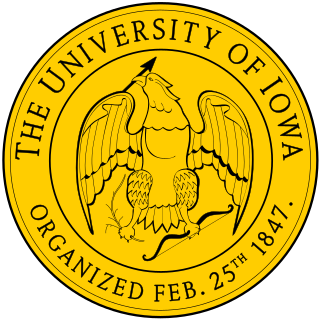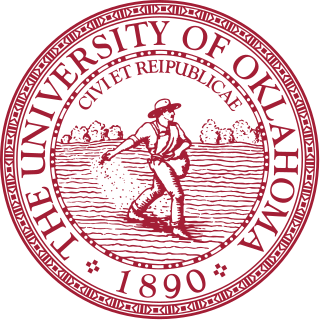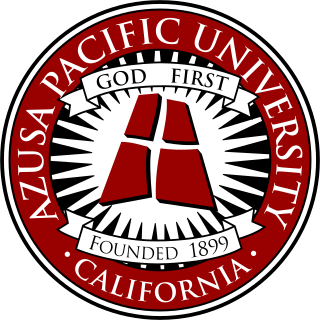
The University of Wisconsin System is a university system of public universities in the U.S. state of Wisconsin. It is one of the largest public higher-education systems in the country, enrolling more than 174,000 students each year and employing approximately 39,000 faculty and staff statewide. The UW System comprises two major doctoral research universities, the University of Wisconsin–Madison and the University of Wisconsin–Milwaukee; eleven comprehensive universities; and thirteen freshman-sophomore branch campuses.

The University of Kansas (KU) is a public research university with its main campus in Lawrence, Kansas. Two branch campuses are in the Kansas City metropolitan area on the Kansas side: the university's medical school and hospital in Kansas City, Kansas, the Edwards Campus in Overland Park. There are also educational and research sites in Garden City, Hays, Leavenworth, Parsons, and Topeka, an agricultural education center in rural north Douglas County, and branches of the medical school in Salina and Wichita. The university is a member of the Association of American Universities and is classified among "R1: Doctoral Universities – Very high research activity".

The University of Iowa is a public research university in Iowa City, Iowa, United States. Founded in 1847, it is the oldest university in the state. The University of Iowa is organized into 12 colleges offering more than 200 areas of study and seven professional degrees.

The University of Oklahoma (OU) is a public research university in Norman, Oklahoma, United States. Founded in 1890, it had existed in Oklahoma Territory near Indian Territory for 17 years before the two territories became the state of Oklahoma. In Fall 2022, the university had 28,840 students enrolled, most at its main campus in Norman. Employing nearly 3,000 faculty members, the university offers 152 baccalaureate programs, 160 master's programs, 75 doctoral programs, and 20 majors at the first professional level.

Azusa Pacific University (APU) is a private, evangelical Christian university in Azusa, California. The university was founded in 1899, with classes opening on March 3, 1900, in Whittier, California, and began offering degrees in 1939. The university's seminary, the Graduate School of Theology, holds to a Wesleyan-Arminian doctrinal theology. APU offers more than 100 associate, bachelor's, master's, and doctoral programs on campus, online, and at seven regional locations across Southern California.

New Mexico State University is a public land-grant research university in Las Cruces, New Mexico. Founded in 1888, it is the state's oldest public institution of higher education and one of two flagship universities in New Mexico. NMSU has campuses in Alamogordo, Doña Ana County, and Grants, as well as research centers and programs in all 33 counties in the state.

Collin College is a public community college district in Texas. Founded in 1985, the district has grown as the county has grown from around 5,000 students in 1986 to more than 58,000 credit and noncredit students.

The University of Alaska System is a system of public universities in the U.S. state of Alaska. It was created in 1917 and comprises three separately accredited universities on 19 campuses. The system serves nearly 30,000 full- and part-time students and offers 400 unique degree programs.

Columbia–Greene Community College is a public community college in Hudson, New York. Founded in 1966, it is part of the State University of New York (SUNY) system and is locally sponsored by two rural counties, Columbia and Greene, which have a combined population of about 112,000. The college was originally in Athens, New York until its permanent relocation to the City of Hudson in 1974. It currently offers 32 associate degree programs and five undergraduate certificate programs. C-GCC is accredited by the Middle States Commission on Higher Education and enrolls approximately 1,578 students as of Fall 2018.

Cameron University is a public university in Lawton, Oklahoma. It offers more than 50 degrees through both undergraduate and graduate programs. The degree programs emphasize the liberal arts, science and technology, and graduate and professional studies. It was founded in 1908, soon after Oklahoma was admitted as a state, as one of six agricultural high schools in the largely rural region.

The University of Science and Arts of Oklahoma (USAO) is a public liberal arts college in Chickasha, Oklahoma. It is the only public college in Oklahoma with a strictly liberal arts–focused curriculum and is a member of the Council of Public Liberal Arts Colleges. USAO is an undergraduate-only institution and grants bachelor's degrees in a variety of subject areas. The school was founded in 1908 as a school for women and from 1912 to 1965 was known as Oklahoma College for Women. It became coeducational in 1965 and today educates approximately 800 students. In 2001, the entire Oklahoma College for Women campus was listed as a national historic district.

Miami Dade College is a public college in Miami, Florida. Founded in 1959, it has a total of eight campuses and twenty-one outreach centers throughout Miami-Dade County. It is the largest college in the Florida College System with more than 100,000 students. The college enrolls a significantly larger number of Hispanic students compared to other colleges and universities in the state of Florida. The college serves a higher number of minority students than any other college in the nation.
Alliance University ) is a private Christian university affiliated with the Christian and Missionary Alliance. Located in New York, New York, the university has offered undergraduate and graduate programs; in addition, it includes Alliance Theological Seminary.

Black Hills State University (BHSU) is a public university in Spearfish, South Dakota. Close to 4,000 students attend classes at its 123-acre (50 ha) campus in Spearfish, with a satellite campus in Rapid City that is shared with South Dakota State University, and through distance offerings. Enrollment comes from 64 out of 66 counties in South Dakota, 43 states, and 29 countries. BHSU is governed by the South Dakota Board of Regents.

Southeastern Oklahoma State University is a public university in Durant, Oklahoma. It had a total enrollment of 5,376 in 2022.

Oregon Coast Community College (OCCC) is a public community college in Newport, Oregon. OCCC serves students in Lincoln County and has approximately 2,000 students and a faculty of 45 people. Of the 17 community colleges in Oregon, only Klamath Community College is younger, and only Tillamook Bay Community College has fewer students.

Northern Oklahoma College (NOC) is a public community college in Tonkawa, Oklahoma, with additional campuses located in Enid, Oklahoma and Stillwater, Oklahoma. Student enrollment is approximately 2,700. NOC bought the former Phillips University in Enid, Oklahoma, in 1999 and it became the NOC Enid campus.

The Oklahoma State Regents for Higher Education is the agency of the government of Oklahoma that serves as the governing body of the Oklahoma State System of Higher Education, which is the largest provider of higher education in the state of Oklahoma. The State System consists of all institutions of higher education in Oklahoma that are supported by direct legislative appropriations from the Oklahoma Legislature.

Chattanooga State Community College is a public community college in Chattanooga, Tennessee. The college is a member of the Tennessee Board of Regents System and is accredited by the Southern Association of Colleges and Schools (SACS). Athletically, Chattanooga State is a member of Region VII of the NJCAA.

The University of Colorado Denver is a public research university located in downtown Denver, Colorado. It is part of the University of Colorado system. Established in 1912 as an extension of the University of Colorado Boulder, CU Denver attained university status and became an independent institution in 1973. CU Denver is the largest research university in Colorado, and is classified among R1: Doctoral Universities - Very High Research Activity. The university's graduate programs award more master's degrees than any other institution in the state, serving roughly 5,000 students annually.




















